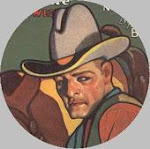Thorndike, Maine (Thorndike Press, 1992). Originally
published 1947.
Many western readers know Peter Dawson is the nom de plume
of Johnathan H. Glidden, brother to Frederick Glidden, better known as Luke
Short. The latter may be the more-recognized name, because a number of his
stories were adapted into well-remembered Hollywood movies, and Short had a
strong career as a writer for the slicks.
Dawson had a long career of his own. I recently read a trio
of his stories in Ghost Brand of the Wishbones,
and as a result wanted to try out a novel-length work by him.
The stories in Ghost Brand were entertaining, but their
artifice as stories was evident: the cause-and-effect of the action that moved
the plot seemed a little forced, as did the romantic elements of the stories.
Something organic was missing. I wondered if the limited lengths of the stories
might have played a part in Dawson’s narratives seeming a bit stilted, and if a
longer form -- the novel -- might allow him more room to build and develop his
story and characters more naturally.
In reading High Country, I think my intuition was correct.
The novel features Jim Sherill’s plans to sell a herd of
horses to prove his worth to the self-proclaimed Commodore Lovelace, a
riverboat magnate, so he may take the hand of the Commodore’s daughter, Ruth,
in marriage. Jim’s plans are thwarted when his herd is stolen. He tracks down
the rustlers, insinuates his way into their camp with a story that they can
throw in together and make money selling stolen horses from Canada to the Army
in nearby Whitewater, and can also send horses rustled nearby from the region for
sale up in Canada.
Along the way, he meets Jean Ruick, running her father’s
ranch after the old man’s death with the help of a trusted old hand, Brick, and her
uncle, Caleb Donovan, whom she doesn’t quite trust. Jim falls for Jean after he
realizes how shallow Ruth actually is and how greedy and domineering the
Commodore truly is -- infatuation had blinded Jim to the faults of both, and
Jean’s integrity and honesty strike home at his heart.
In the course of the novel, Jim wins over one of the
rustler’s lieutenants, and the two steal back Jim’s herd. Donovan’s involvement
in the rustling is revealed, and Jim loses his herd again -- and Jean’s trusted
hand, Brick, is murdered.
If this plot sounds convoluted, it’s so only because I’ve
condensed the narrative so concisely. Peter Dawson pulls it all off very
nicely. In the limited confines of a short story or novelette, this plot
wouldn’t have worked at all. But in the more forgiving parameters of a novel,
Dawson uses the larger narrative space to construct a world, a situation, with
fully developed characters and with appropriate pacing to end up with a very
enjoyable story.
By the end of the tale, we reach a very satisfactory wrap
up. The bad guys get their deserved comeuppance, and the weary and hard-working
good guys -- and gals -- end up in one another’s arms.
I’m pleased that my curiosity led me to try out Dawson’s
efforts in the longer form. I’m also pleased to say that I’ll be looking for
more Peter Dawson novels to read.






1 comment:
Finally someone else who has found and who likes Dawson. Been a fan for years.
Post a Comment